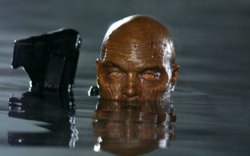George A. Romero's Land of the Dead
reviewed by eric m. hoover

If you are going to see a film like George A. Romero's Land of the Dead it is best to view a midnight showing — and if all possible to do it in New York City.
There, you will not only get the fulfillment of an entertaining forth installment from Romero’s classic zombie gore-series but you’ll also catch an inadvertent freak show. Between hipster teenagers dressed in Abercrombie and squeaky-clean Converse and the couple wearing fake blood with torn straightjackets it will be easy to spot who is going to see Herbie: Full Throttle.
The film starts off with a quick montage via news clips on what’s happened over the course of the past three films. We hear the screams of innocents being devoured and ripped apart accompanied by stereotypical monster flick horror-Goth music.
The opening description basically covers what you see and hear in this film. Stars Simon Baker, John Leguizamo and the overpoweringly attractive Asia Argento battle the now thinking and machinegun-wielding zombies — who have adapted to their new life much like the Raptors of Jurassic Park learned to operate door handles.
Lest we forget the inept soldiers who always end up as easy pickings for whatever monster is being fought. Even the best-trained snipers could not seem to put a scratch on the large African American zombie heading the pact (Eugene Clark as Big Daddy).
Aside from the issues of the undead, Land of the Dead is riddled with Writer/Director Romero’s political commentary. The film turns into a metaphor for the struggle of lower-class citizens. Dennis Hopper’s Bush-like character (spouting slogans such as “We do not negotiate with terrorists.”) traps the oppressed working families on the outskirts of the walled up and river surrounded city. They are given little food, even less cash and are forced to sacrifice each other for survival.
The upper class families are safe in their sealed and water-protected inner city limits, which resemble the shopping mall setting from Dawn of the Dead. That is, until the zombies figure out how the non-living can cross a river and devour the well-to-do urban dwellers.
Our blue-collar heroes are left to deal with slaughtering humans in order to destroy a contingent of zombies, while pondering the sudden shift that has made the undead want to become so human. The “Stenches”, as the decomposing creatures are referred to, attempt to live normal lives and act out routine events such as pumping gas or playing the tambourine. And does their move to apathy mean they too must become a sort of second-class citizen instead of mere target practice for other cross-eyed guardsmen?
Before the credits roll you almost want to sympathize with the zombies as though their plight was a just cause. Both the living and he dead share a common goal for survival at any means necessary—whether that be through walling yourself up in an impenetrable city or tearing humans into chunks depends on whether or not you still breath.
{Any questions/comments — Drop a line to Eric at equalmusic dot com}
Copyright (c) 2005 erasing clouds |
|